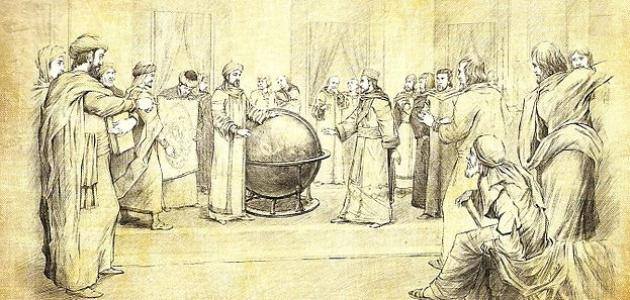ملابس آخر سلاطين بني نصر في غرناطة محمد بن علي بن سعد : دراسة مستقاة من المصادر التاريخية والوثائق الأثرية
Clothes of the last Sultans of Bani Nasr in Granada, Muhammad bin Ali bin Saad A study drawn from historical sources and archaeological documents

اعداد : د. حليم سرحان (جامعة المسيلة /الجزائر)
- المركز الديمقراطي العربي –
-
مجلة الدراسات الثقافية واللغوية والفنية : العدد السابع عشر شباط – فبراير 2021 ،المجلد 5 – مجلة دولية محكمة تصدر عن المركز الديمقراطي العربي المانيا- برلين.
- تعنى بنشر الدراسات والبحوث في التخصصات الأنثروبولوجيا واللغات والترجمة والآداب والعلوم الاسلامية والعلوم الفنية وعلوم الآثار.كما تعنى المجلة بالبحوث والدراسات الاكاديمية الرصينة التي يكون موضوعها متعلقا بجميع مجالات علوم اللغة والترجمة والعلوم الإسلامية والآداب، وكذا العلوم الفنية وعلوم الآثار، للوصول الى الحقيقة العلمية والفكرية المرجوة من البحث العلمي، والسعي وراء تشجيع الباحثين للقيام بأبحاث علمية رصينة.
Journal of cultural linguistic and artistic studies
للأطلاع على البحث “pdf” من خلال الرابط المرفق :-
الملخص :
لا شك أن ملابس السلاطين تكتسي أهمية بالغة في دراسة تاريخ، وآثار الحضارة العربية الإسلامية وما وصلت إليه من تقدم ورقي يعكس الحالة السياسية، والاقتصادية، والاجتماعية من استقرار أو اضطراب في بلاطات هؤلاء السلاطين أصحاب هذه الملبوسات. وعلى هذا الأساس جاءت هذه الدراسة لتلقي الأضواء الكاشفة على ملابس آخر سلاطين الإسلام في إسبانيا محمد بن علي بن سعد، وإبراز استمرار الطراز العربي الإسلامي ذي الأصول المشرقية الذي وفد مع الفاتحين الأوائل. وهي دراسة جديدة في بابها لأن دراسة الملابس عامة، وملابس السلطان النصري خاصة لم تحظ باهتمام الباحثين لندرة المادة العلمية، وتفرقها في بطون المصنفات التاريخية والأدبية، من جهة. ولتضارب المصطلحات الخاصة بالألبسة، وفقر المعاجم العربية من جهة ثانية. وقد حاولنا تلافي هذا النقص الفادح من خلال جمع شتات كل ما له علاقة بملابس السلطان النصري من إشارات وردت في النصوص المعاصرة له سواء كانت تاريخية أو جغرافية، أو غيرها، وربطها بما تبقى من الآثار المحفوظة في قصر الحمراء بمدينة غرناطة، والمتاحف العالمية التي لا زالت تحوز بعضا من هذه الملابس على الأقل في شكل مجسمات، وتماثيل من الشمع، وذلك لتوضيح الصورة وتقريبها أكثر ووضعها سائغة بين يدي المتخصصين. وقد توصلنا إلى وضع نموذج أمثل لملابس هذا السلطان بناء على ما قدمناه من أراء مسنودة بالوثائق الأثرية المتاحة. وهكذا أصبحت ملابس آخر السلاطين المسلمين في الأندلس واضحة المعالم بعدما كانت مجهولة، ومتفرقة هنا، وهناك بعيدا عن متناول الدارسين.
Abstract
There is no doubt that the sultans ’clothes are of great importance in studying the history and effects of the Arab-Islamic civilization and the progress it has reached in terms of the political, economic, and social situation of stability or turmoil in the tiles of these sultans who own these clothes. On this basis, this study came to shed light on the clothes of the last sultans of Islam in Spain, Muhammad bin Ali bin Saad, and to highlight the continuation of the Arab-Islamic style with Levantine origins that came with the early conquerors. It is a new study in its section because the study of clothes in general, and the clothes of the Nasrid Sultan in particular, did not receive the attention of researchers due to the scarcity of scientific material, and its dispersion in the stomachs of historical and literary works, on the one hand. There is also a conflict of clothing terminology and the poverty of Arabic dictionaries on the other hand. We have tried to avoid this critical deficiency by collecting all that is related to the clothes of the Nasrid Sultan from references made in his contemporary texts, whether historical, geographical, or other, and linking them with the remaining monuments preserved in the Alhambra in Granada, and the international museums that are still She holds at least some of these clothes in the form of figures, and statues of wax, in order to clarify the image and bring it closer and put it in the hands of specialists. We have come to develop an optimal model for this sultan’s clothes based on the opinions we presented that are supported by the available archaeological documents. Thus, the clothes of the last Muslim sultans in Andalusia became clear after they were unknown, and scattered here and there, out of reach of scholars.




